The Economic & Political History of Sudan Part II: From the 1st Southern Rebellion to the 2nd
A Tale of How One Man ended a war only to ignite another, Oil Discoveries, and a Failed Agricultural Revolution
In Part 1, I delved into Sudan's vibrant pre-colonial past, followed by Turkish-Egyptian and British-Egyptian colonial rule. On the cusp of independence, the North-South divide sparked the first South Sudanese rebellion/Sudanese Civil War. Meanwhile, economic woes from failed cotton harvests, corruption, and Khartoum riots led to General Abboud's 1958 coup, ushering in a new era of military rule.
Military Rule: General Ibrahim Abboud (1958-1964)
General Ibrahim Abboud formed the Supreme Council of Armed Forces, an Islamist-military alliance dominated by Northern Afro-Arabs. Initially, Sudanese citizens welcomed the coup, hoping for stability and economic revival.
South Sudanese Rebellion/Sudanese Civil War: However, Abboud's response to the South Sudanese Rebellion was swift and severe: he declared a state of emergency, suspended the constitution, and deployed additional troops to quell Southern secessionist ambitions.
General Abboud viewed Christianity as a form of mental colonialism and African Animism as primitive. He imposed Arabization and Islamization policies in the South, supplanting traditional laws with Sharia and enforcing Arabic as the sole language for government services.
By the 1960s, General Abboud had replaced over 300 Christian missionary schools with Islamic ones and deported many missionaries.
South Sudanese Christians fled to Uganda, forming the “Anya Nya” rebel group, fighting back with bows, spears, swords, machetes, and arrows.
Abboud launched "Cleansing the South" operations, targeting rebels with explosives and antiaircraft rifles from the UK, China, USSR, Yugoslavia, and neighboring Arab countries. He even sent troops to South Sudanese refugee camps in neighboring countries to convert or slaughter them.
Northern issues: Egypt and Sudan initially disagreed on water rights on the Nile River. So, Nasser and Abboud split the Nile in 1959. (Egypt’s share was 55.5B cubic meters, Sudan had 18.5B cubic meters). Egypt provided arms & foreign aid for Abboud, and in return, Abboud violently resettled Nubians so Nasser can make his Aswan Dam.
Economy: Sudan's economy relied on cotton exports, resulting in a trade deficit due to high imports of modern goods. Using cotton revenue and foreign aid from Arab Neighbors, the World Bank & UK, Abboud initiated a state-led, 10-year modernization plan, focusing on Northern infrastructure & healthcare while neglecting the non-Arab Darfur and the South. Despite building railways, roads, and irrigation projects like the Girba Dam, insufficient cotton production failed to service foreign debt. Oil exploration was unsuccessful (for now…), though an oil refinery was built in Port Sudan. Wealth disparities grew, with places like Omdurman, Khartoum, Kosti, and Sennar being significantly richer than Darfur and South Sudan.
October Revolution:
The October Revolution of 1964, sparked by economic woes and South Sudan's escalating crisis, forced General Abboud to step down amidst violent protests at the University of Khartoum.
Transitional Rule: Sir al-Khatim al-Khalifa (1964-1965)
Sir al-Khatim al-Khalifa, led the Islamist Ummah Party, led the interim government until the 1965 elections.
Despite attempts to negotiate with South Sudanese representatives at the Round Table Conference, the talks failed.
The 1965 elections saw the Ummah Party form a coalition government with the Arab Nationalist National Unity Party, while communists secured a minor presence with 8 seats out of 186.
Civilian Rule: (1965-1969)
Muhammed Ahmad Mahjub (1965-1966)
Prime Minister Muhammed Ahmad Mahjub, leader of the Islamist Ummah Party, took office after the 1965 elections. Mahjub had two priorities - banning the communist party (Communists are atheists, a belief deemed intolerable in a Muslim nation) and ending the southern insurgency.
Southern Rebellion/Sudanese Civil War: He started a brutal campaign against the rebels. The Sudanese army rampaged cities like Malakal, Juba and Wau, burned churches & huts, closed schools, shot up weddings, and destroyed crops and cattle, thousands died.
As one South Sudanese said this was “indisputable proof of our contention that the Northern Army under the orders of the government is carrying out a genocide and systematic extermination of the Negro population of Southern Sudan.”
In 1965, Mahjub's government collapsed due to lost confidence, and Sadiq al-Mahdi of the Umma Islamist Party succeeded him as Prime Minister.
Sadiq al-Mahdi (1966-1967)
South Sudanese Rebellion: Sadiq al-Mahdi's approach to the South Sudanese Rebellion involved forcibly relocating Southerners to camps, where many died on the trek or amidst a devastating cholera outbreak. This costly resettlement campaign led to Sudan's first IMF loan in 1966.
After a failed communist coup attempt, al-Mahdi cracked down on communists, killing many. He then pursued reconciliation efforts with the South, including proposals for autonomy and a Southern VP. This plan backfired, as he lost support from Nationalists and Islamists. Muhammed Ahmad Mahjub returned as Prime Minister in 1967.
Muhammed Ahmad Mahjub (1967-1969)
Arab-Israeli Conflict
Due to a dangerous game of brinksmanship and due to Nasser of Egypt closing the Straits of Tiran, inhibiting Israeli trade, Israel struck Egypt, kickstarting the Six Day war.
Other countries like Syria, Jordan, Iraq, and Sudanese volunteer forces joined as well. Israel then won and took Golan from Syria, West Bank & East Jerusalem from Jordan, and Gaza & the Sinai from Egypt.
Following the Arab states' defeat, the Arab League's Khartoum conference adopted the "Three No's" policy: no peace, no negotiation, and no recognition of Israel. Sudan's support for Egypt and its ongoing campaign against the South had drained its resources, leading to bankruptcy and two more IMF loans. In 1969, the military, led by Jaafar Nimeiry, seized power in the May Revolution, ousting al-Mahdi and establishing a one-party socialist state under the Sudanese Socialist Union.
Colonial Jaafar Mohammed al-Nimeiry (1969-1985)
Leftist Nimeiry: Jaafar Nimeiry, who came to power in 1969, securing $100M in weapons from the Soviet Union, Czechoslovakia, and Yugoslavia to defeat the South and initially pursued a leftist agenda. As common in socialist states, the government controls the “commanding heights of the economy”. He nationalized industries, businesses, foreign banks, and pursued state-led growth. He cracked down hard on Islamists and had communists in his administration, like John Garang, a Southerner.
Mixed economy Nimeiry: In a typical show of leftist infighting, Jaafar was briefly removed in a coup by the communists in 1971. Anwar Sadat of Egypt and Muammar Ghaddafi of Libya opposed the coup and in less than a week later Jaafar loyalists instigated a counter coup, killed the communists, expelled the Southern Marxist John Garang, and reinstated Nimeiry. Nimeiry turned against the communist bloc and established a more liberal foreign investment law.
Peaceful Nimeiry: Israel, under Prime Minister, Golda Meir, trained the Southern Anya Nya rebels, using Uganda and Ethiopia has conduit states. The Organization of African Unity didn’t do anything because its charter stated non interference. Israel’s strategic interest was destabilizing Egypt, via Sudan, and the Southern rebels were perfect instruments in their objective. In 1971, besides the Anya Nya, another rebel group called the Southern Sudan Liberation Movement (SSLM) emerged. By 1972, Nimeiry decided this war must end.
In the Addis Ababa Accords of 1972, Sudan made peace with South Sudan and granted the region autonomy. The result was the three separate provinces were combined and put in its own region. Also in the agreement, was that if South Sudan had oil, they would receive a huge chunk of that (we’ll see…). The Anya Nya were integrated in the Sudanese army. Muslims can have Sharia and the Animists/Christians in the South can have customary law and their own legislative council, elections, and tax policy. The 1st South Sudanese Rebellion/Civil War ended. From 1955 to 1972, 1.3M died.
Nimeiry also promised the South irrigation schemes, a state owned sugar factory, roads, hospitals, schools, and bridges along the Jonglei canal project in 1972. Barely any of these finished. Lastly, the North and South also couldn’t agree if Abyei would be North or South since Dinkas (Southerners) and Arabs lived in that area.
As you can imagine, not all Southerners were satisfied, leading to ongoing dissatisfaction, mutinies, & defections in 1975 and 1976. Also the south was chronically dependent on the North. Not to mention that the Southern government was incredibly tribalistic, nepotistic, and corrupt with client- patronage culture. Jaafar also interfered with appointments/nominations in the South in 1978.
Now that the Southern issue is “solved”, Jaafar could finally focus more on economic development.
“Green Revolution” Nimeiry:
In the 1973 Arab-Israeli war, Nimeiry sent some troops to help Egypt and Syria retake the Sinai, Golan, and crush Israel, but they failed.
The Gulf states, took revenge on the West by launching their oil embargo and decreasing oil production, increasing global oil prices. These countries had massive current account surpluses now (they exported more oil than they imported foreign goods: In the mid 1970s, Saudi Arabia’s & Kuwait’s surpluses were 50% of their GDP).
Nimeiry pitched Sudan’s abundant land to Gulf states for agricultural investment. Nimeiry believed that with foreign capital, he can make Sudan the “Breadbasket of the The Arab World”. He also took low interest loans, grants, and aid from America, the European Economic Community and the World Bank to fund his forward thinking strategy.
Most of the investments focused on infrastructure, sugar, wheat, & cotton production such as the rural development schemes in Abyei, Blue Nile, and the Jonglei Canal, ignoring South Sudan’s water rights and expropriating their fertile lands in Blue Nile & South Kordofan. His goal was also to use cotton to make textiles.
The idea was great in theory, but implementation was terrible. Many projects like the Jonglei Canal project was abandoned. Sudan still doesn’t export much in clothes. Look below to see how yields barely budged.
Sudan borrowed substantial sums of money, increasing its external debt from $390M in 1970 to $9B by 1985, reflecting an average compound annual growth rate (CAGR) of 23%. However, the pay off was meager.
Under Nimeiry’s 15-year rule, growth in wheat, cotton, and sugar were all mediocre. Growing debt at 23% per year to achieve minimal increases in wheat, sugar, and cotton yields (3%, 1%, and 1% per year respectively) was grossly inefficient.
Few projects were completed on time, and those that were, did not meet production targets. The sugar refineries were almost entirely unprofitable and factories operated at less than 50% capacity.
Seven key reasons led to the failure of Jaafar's plans:
Poor Planning: Decisions were inconsistent, with ministries negotiating loans without central approval, leading to disorganization.
Soaring Oil Prices strained finances.
Brain Drain: The most skilled Sudanese were leaving for better opportunities in the Gulf. Sudanese could do menial jobs and those countries, and it would still be a better salary than what they could receive in Sudan.
Falling Wheat Prices from 1974 to 1981 reduced Sudan’s export revenue
Insecure Property Rights for farmers
Unpredictable Rainfall for areas lacking proper irrigation. There was a drought in the early 1980s.
As a result, Sudan approached bankruptcy seven times under Nimeiry, requiring repeated IMF bailouts and debt rescheduling from the Paris Club. With IMF loans, Nimeiry started to privatize inefficient state owned corporations, let his currency float, and remove subsidies.
Islamist Nimeiri: After falling out with communists and an attempted Islamist coup, Nimeiri sought national reconciliation with the Islamists like Hassan al-Turabi of the Muslim Brotherhood to maintain his grip on power.
This alliance was significant because Nimeiri historically had more affinity with Sufi Islam, which emphasizes personal spirituality, tolerance, and mysticism. In contrast, the Muslim Brotherhood's Islamism focuses on governing a nation through Islamic principles.
Many Islamist political prisoners were freed and exiled Islamists were allowed to return. The Muslim Brotherhood started to dominate Sudan’s civil service. With their counsel, Nimeiri reinstated Sharia in the Christian/Animist South Sudan.
Geopolitics of Nimeiry:
Issues with Ethiopia:
Ethiopia’s monarchy was overthrown and replaced with a Communist military government under Mengistu Halie Mariam. Nimeiry was anti-communist so he funded Tigray, Eritrean, Gabala, and Oromo militias to destroy Communist Ethiopia. By becoming anti-Communist, starting under Jimmy Carter, Sudan became the second largest African recipient of US aid after Egypt. Meanwhile, Mariam funded the Anya Nya-2 in South Sudan.
Issues with Libya:
If you read my article on Chad, you would know that during this time, Gaddafi was determined to annex Chad, believing the Aouzou Strip contained uranium (very few has been found so far). In 1973, Gaddafi was covertly operating in Darfur, to support his ambitions in Chad. Despite Gaddafi’s actions, Nimeiry initially maintained good relations with him, as Gaddafi had once saved him from a coup and attempted to unite their nations.
Gaddafi made several attempts uniting with Sudan, Chad, Egypt, Syria, Iraq, Algeria, and Tunisia but he was repeatedly rebuffed. Nimeiri even remarked that Gaddafi “has a split personality - both parts evil.” Feeling betrayed by Nimeiry's support for the West and opposition to his annexation of Chad, Gaddafi tried to multiple coups to remove Nimeiri and funded mercenaries to kill him.
Issues with Iran: As per Arab League mandate, Nimeiry supported Iraq against Iran, which just had their Iranian Revolution.
Secret Rapprochement with Israel: Nimeiri did not want Israel to interfere in Sudan’s affairs again. So he allowed Israel’s intelligence agency, the Mossad, to have a secret presence in Khartoum and Nimeiri helped bring Ethiopian Jews to Israel.
Oil Nimeiry:
Nimeiry invited foreign investors to explore for oil in Sudan, contracting the American firm, Chevron.
Chevron later discovered significant oil fields in South Sudan's Upper Nile and Southern Kordofan regions in 1978 and 1979, leading the Sudanese government to issue drilling licenses to multiple firms which you can see below.
Nimeiry reneged on the Addis Ababa Treaty, abolishing South Sudan's autonomy and seizing its oil. He redeployed troops to the South, redivided the region in its three original provinces, and imposed Sharia law.
All of these issues led to the creation of the Southern People’s Liberation Army (SPLA) and the onset of the Second South Sudanese Rebellion/Second Sudanese Civil War in 1983. The SPLA, led by former colleague, John Garang, sought to overthrow the Sudanese government and create a socialist, secular, and democratic Sudan.
Because John Garang was a Marxist, Nimeiry was able to convince Reagan to get more arms against communist Ethiopia, Gaddafi, and Marxists in South Sudan. Always happy to kill a communist, Reagan provided arms to Nimeiry. The Soviets funded Communist Ethiopia, which funded the Anya Nya and SPLM. This was the longest civil war in African History. The violence became so bad that Chevron left. Human rights violations were committed on both sides.
Nimeiry provided Baggara Arabs, who hated the Dinka Southerners over land disputes, automatic weapons. The Baggara rode horses to massacre Southern Sudanese, burn their farms, and steal their cattle.
Sudan’s economy was in shambles, a drought killed killed 100K Darfurians and Sudan needed a US & UN food program to prevent mass death, inflation was high, refugees from Ethiopia & Chad came pouring in, power cuts were rife, and infrastructure projects were unfinished.
The Darfur people made a song that said “If Reagan had not come we would have died of hunger.” According to Human Rights Activist, Alex de Waal, he said that Numeri’s “delayed response caused an entirely preventable tragedy [that] cost an estimated 250K lives.”
In April 1985, riots erupted in Khartoum, known as the April Intifada, led by Sudanese activists and intellectuals. The military saw these massive riots as a sign that Nimeiry lost legitimacy and removed Nimeiry in a coup. The country was briefly ruled by an interim government that tried negotiating with the rebels in South Sudan but failed.
At election time, Sadiq al-Mahdi, won the elections and ruled again.
Sadiq al-Mahdi (again) (1986-1989)
Mahdi received debt relief from the London Club, a group of private creditors.
Brutality: Sadiq wanted to Arabize and Islamize the South by force and ignored John Garang & his SPLM. Sadiq didn’t trust the Sudanese army, fearing they would coup him, and in South Sudan, he noticed that other Sudanese didn’t like the Dinka tribe. So he bribed the Baggara Arabs, now known as the Murahaleen, to burn Dinka South Sudanese alive. 1000s of South Sudanese were sold into slavery in Libya and/or forced converted to Islam. Sadiq funded another miltia - the Rizayqat to commit atrocities in Darfur for clashing with Arabs.
The Murahaleen served as a cheap & deniable counterinsurgency tool for the government to avoid war crimes. This led to starvation in the South.
In 1986, the UN launched “Operation Rainbow” to provide food aid to famine-stricken South Sudan, but Sadiq al-Mahdi refused to guarantee its delivery. Due to the famine, many Dinka and Nuer families abandoned their sons but kept their daughters. (Many South Sudanese practiced a dowry system, where they can sell off her daughters for cash/cattle. Dowry existed in India, Europe, and China too.).
If the these “Lost Boys” were unlucky, they became perfect recruits for the South Sudanese to get more rebels or new slaves for Northern Arab Sudanese raiders. If they were lucky, some Western NGO, UN Refugee camp, or Christian Missionary program would find them and give them healthcare and education. George H.W. Bush himself provided millions in aid to the South Sudanese kids via “Operation Lifeline Sudan”.
The SPLM pushed back the Murahaleen militia into Darfur. Sadiq reorganized the Murahaleen militia into his direct control as the “Popular Defense Forces”. Then the SPLM united with the other Southern militia, Anya Nya-2, and captured a bunch of territory and their Southern capital Juba by 1989.
Seeing the Southern rebels' victories, the Sudanese Army viewed Sadiq as ineffective. In 1989, as Sadiq was about to negotiate with the South, a group of Islamist officers arrested and overthrew him, placing Omar Al Bashir in control.
Final Thoughts
Sudan's tragic history is marred by leaders, both military strongmen and democratically elected officials, who have consistently chosen violence over peace pertaining to the South Sudanese people. However, it was the enigma, Jaafar Nimeiry, who briefly united the country through his chameleon-like adaptability. I find Nimeiry fascinating, as he transformed from a pro-Soviet, leftist, anti-Islamist, pro-Gaddafi, anti-Zionist to a pro-American, semi-pro capitalist, Islamist, anti-Gaddafi leader who secretly collaborated with Israeli Mossad agents.
Unlike many African leaders, Nimeiry recognized the significance of agricultural production beyond cash crops. Yet, he still succumbed to the pitfalls of excessive borrowing and corruption, characteristic of many African government. The discovery of oil proved to be a lifeline for Sudan, as nothing else seemed to be working at the time. Ironically, Nimeiry, the man who ended the 1st Sudanese civil war, started the 2nd one.
Click here for Part 3, where we’ll discuss Omar Al Bashir’s rule, South Sudanese independence, and the current Sudanese Civil War.


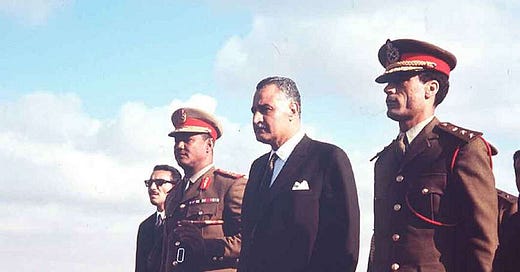




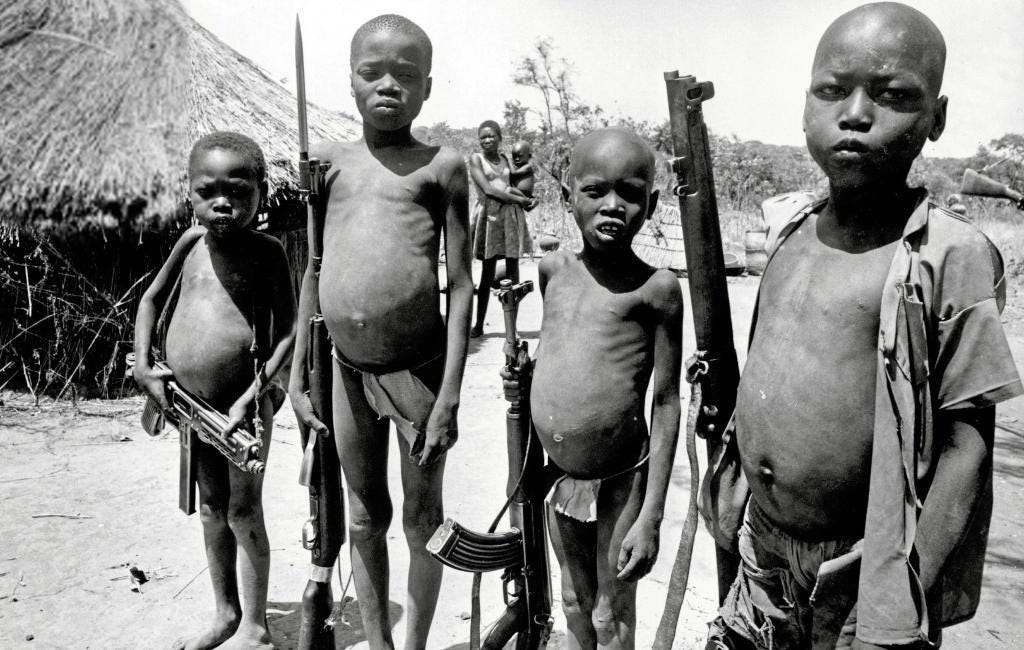

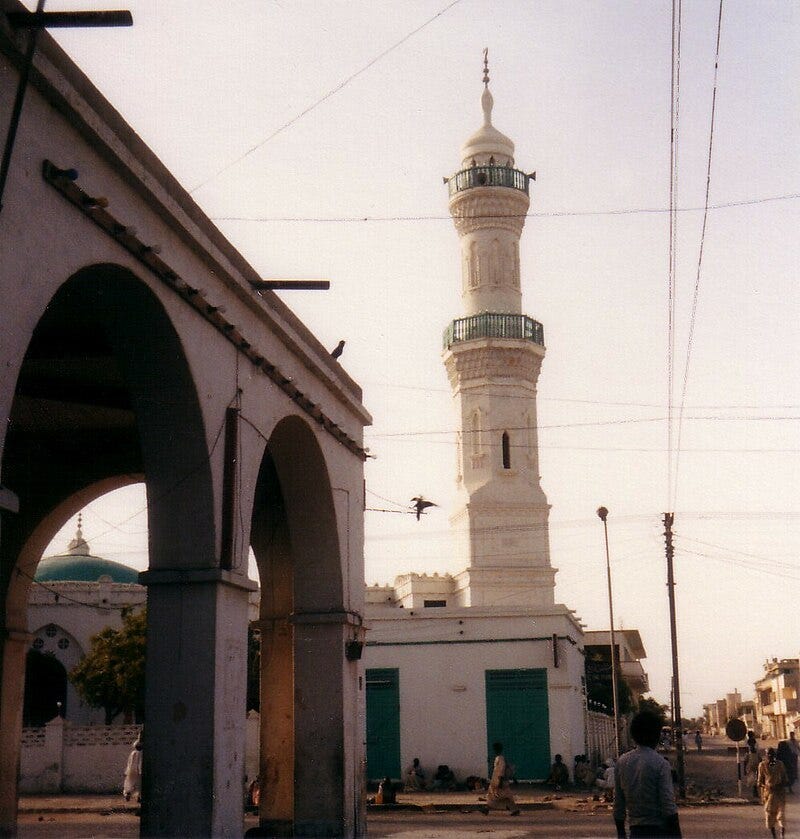
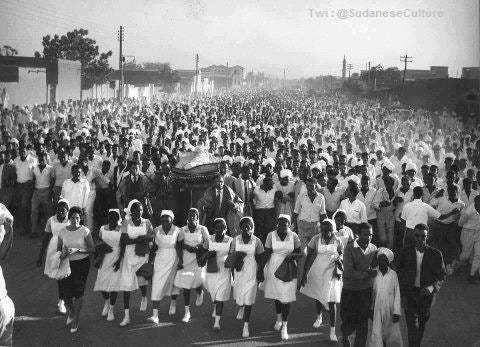
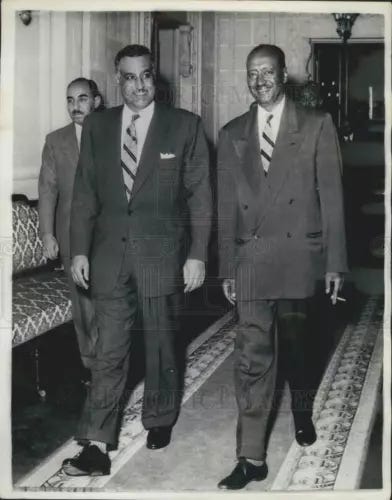
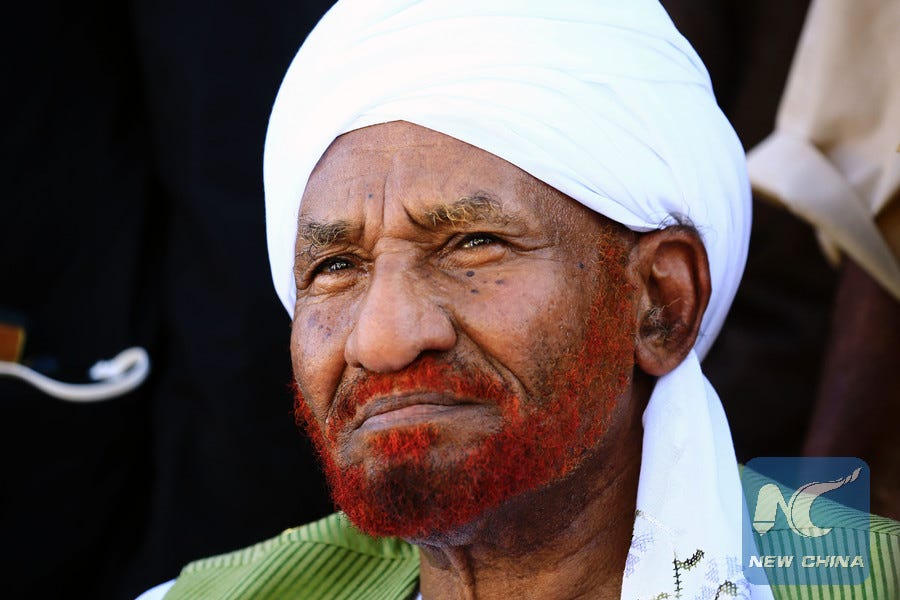


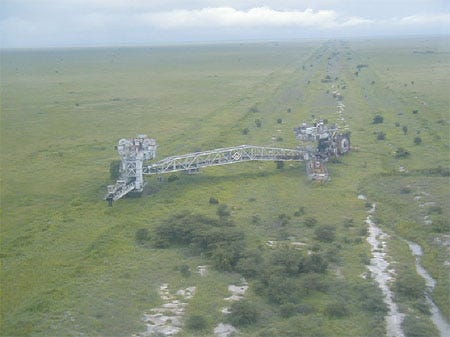
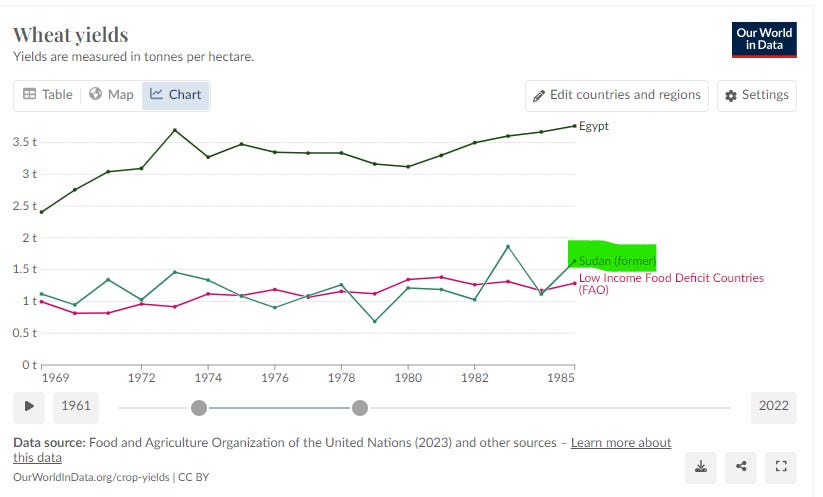






> Nimeiry pitched Sudan’s abundant land to Gulf states for agricultural investment. Nimeiry believed that with foreign capital, he can make Sudan the “Breadbasket of the The Arab World”.
I don't get you even fuck up feudalism.
Thanks for this